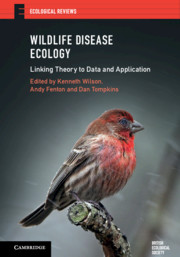Book contents
- Wildlife Disease Ecology
- Ecological Reviews
- Wildlife Disease Ecology
- Copyright page
- Contents
- Contributors
- Preface: Wildlife Disease Ecology
- Glossary of Terms
- Part I Understanding within-host processes
- Part II Understanding between-host processes
- Chapter Eight Using insect baculoviruses to understand how population structure affects disease spread
- Chapter Nine Infection and invasion: study cases from aquatic communities
- Chapter Ten Parasite-mediated selection in red grouse – consequences for population dynamics and mate choice
- Chapter Eleven Emergence, transmission and evolution of an uncommon enemy: Tasmanian devil facial tumour disease
- Chapter Twelve Bovine tuberculosis in badgers: sociality, infection and demography in a social mammal
- Chapter Thirteen Mycoplasma ovipneumoniae in bighorn sheep: from exploration to action
- Chapter Fourteen Manipulating parasites in an Arctic herbivore: gastrointestinal nematodes and the population regulation of Svalbard reindeer
- Part III Understanding wildlife disease ecology at the community and landscape level
- Index
- Plate Section (PDF Only)
- References
Chapter Twelve - Bovine tuberculosis in badgers: sociality, infection and demography in a social mammal
from Part II - Understanding between-host processes
Published online by Cambridge University Press: 28 October 2019
- Wildlife Disease Ecology
- Ecological Reviews
- Wildlife Disease Ecology
- Copyright page
- Contents
- Contributors
- Preface: Wildlife Disease Ecology
- Glossary of Terms
- Part I Understanding within-host processes
- Part II Understanding between-host processes
- Chapter Eight Using insect baculoviruses to understand how population structure affects disease spread
- Chapter Nine Infection and invasion: study cases from aquatic communities
- Chapter Ten Parasite-mediated selection in red grouse – consequences for population dynamics and mate choice
- Chapter Eleven Emergence, transmission and evolution of an uncommon enemy: Tasmanian devil facial tumour disease
- Chapter Twelve Bovine tuberculosis in badgers: sociality, infection and demography in a social mammal
- Chapter Thirteen Mycoplasma ovipneumoniae in bighorn sheep: from exploration to action
- Chapter Fourteen Manipulating parasites in an Arctic herbivore: gastrointestinal nematodes and the population regulation of Svalbard reindeer
- Part III Understanding wildlife disease ecology at the community and landscape level
- Index
- Plate Section (PDF Only)
- References
Summary
Badgers are an important reservoir of bovine TB in the UK. We discuss how the combination of individual epidemiological data, tracking studies and modelling frameworks enabled exploration of host–pathogen theories in relation to badger life history and disease ecology, focusing on heterogeneity in host susceptibility and infectiousness, two components of the superspreader phenotype. Studies pairing empirical data with modelling approaches suggest sex differences are underpinned by immunological mechanisms. We discuss how studies have moved away from the simplistic assumption of randomly mixing homogeneous populations towards recognition of heterogeneity in host association patterns at group, class and individual levels. Interactions between individuals are non-random with high within-group contacts and lower between-group contact rates. Contact heterogeneity is fundamental to understanding what drives/restricts the spatial spread of disease through a population. We explore a demographic perspective on disease ecology, showing how demographic intricacies provide further understanding of the mechanisms underpinning persistence of infected badger populations. The understanding gained from longitudinal studies of host–pathogen field systems is important ecological and epidemiological theory development and informs evidence-based disease control strategies’ development.
Keywords
- Type
- Chapter
- Information
- Wildlife Disease EcologyLinking Theory to Data and Application, pp. 342 - 367Publisher: Cambridge University PressPrint publication year: 2019
References
- 3
- Cited by



